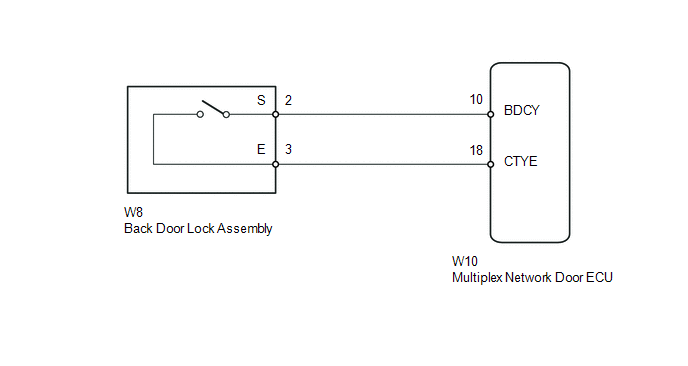Toyota 4Runner: Back Door Courtesy Switch Circuit
DESCRIPTION
The multiplex network door ECU receives a back door open/closed signal from the back door lock.
WIRING DIAGRAM

PROCEDURE
|
1. |
READ VALUE USING TECHSTREAM (BACK DOOR COURTESY LIGHT SWITCH) |
(a) Using the Techstream, read the Data List (See page
.gif) ).
).
Back Door
|
Tester Display |
Measurement Item/Range |
Normal Condition |
Diagnostic Note |
|---|---|---|---|
|
Back Door Courtesy Switch |
Back door courtesy light switch signal / ON or OFF |
ON: Back door open OFF: Back door closed |
- |
OK:
Tester display changes according to opening and closing of back door.
| OK | .gif) |
PROCEED TO NEXT SUSPECTED AREA SHOWN IN PROBLEM SYMPTOMS TABLE |
|
|
2. |
INSPECT BACK DOOR LOCK ASSEMBLY (BACK DOOR COURTESY LIGHT SWITCH) |
(a) Remove the back door lock (See page .gif) ).
).
.png)
(b) Measure the resistance according to the value(s) in the table below.
Standard Resistance:
|
Tester Connection |
Condition |
Specified Condition |
|---|---|---|
|
2 - 3 |
Open-latch |
Below 1 Ω |
|
Full-latch |
10 kΩ or higher |
.png) |
Full-latch |
.png) |
Open-latch |
| NG | .gif) |
REPLACE BACK DOOR LOCK ASSEMBLY |
|
|
3. |
CHECK HARNESS AND CONNECTOR (BACK DOOR LOCK ASSEMBLY - MULTIPLEX NETWORK DOOR ECU) |
(a) Disconnect the W8 back door lock connector.
(b) Disconnect the W10 multiplex network door ECU connector.
(c) Measure the resistance according to the value(s) in the table below.
Standard Resistance:
|
Tester Connection |
Condition |
Specified Condition |
|---|---|---|
|
W8-2 (S) - W10-10 (BDCY) |
Always |
Below 1 Ω |
|
W8-2 (S) - Body ground |
Always |
10 kΩ or higher |
|
W8-3 (E) - W10-18 (CTYE) |
Always |
Below 1 Ω |
|
W8-3 (E) - Body ground |
Always |
10 kΩ or higher |
| OK | .gif) |
REPLACE MULTIPLEX NETWORK DOOR ECU |
| NG | .gif) |
REPAIR OR REPLACE HARNESS OR CONNECTOR |
 IG Signal Circuit
IG Signal Circuit
DESCRIPTION
This circuit detects the ignition switch ON or off condition, and sends it to
the main body ECU.
WIRING DIAGRAM
CAUTION / NOTICE / HINT
NOTICE:
Inspect the fuses for circuits rela ...
 Door Courtesy Switch Circuit
Door Courtesy Switch Circuit
DESCRIPTION
The main body ECU (multiplex network body ECU) receives a door open/closed signal
from each door courtesy light switch.
WIRING DIAGRAM
PROCEDURE
1.
READ VALU ...
Other materials about Toyota 4Runner:
Accumulator Low Pressure (C1452)
DESCRIPTION
DTC Code
DTC Detection Condition
Trouble Area
C1452
After braking, the fluid pressure inside the accumulator is below the
threshold within 3.2 seconds.
Hydrauli ...
Diagnostic Trouble Code Chart
DIAGNOSTIC TROUBLE CODE CHART
If a trouble code is output during the DTC check, inspect the trouble
areas listed for that code. For details of the code, refer to the "See page"
below.
When the SRS warning light remains on and the ...
0.0316

.gif)